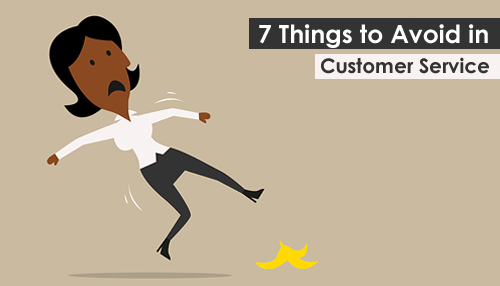Smart companies understand the importance of customer service. They know that great customer service is a key driver of customer retention and loyalty, which results in greater profitability.
Smart companies take customer service seriously. However, being smart is not the same as being perfect. Even intelligent, customer-centric companies make customer service mistakes. These mistakes stem from many places: inertia, habit, or simply bad choices; however, everyone can be remedied with some focused effort.
Below are seven customer service mistakes I see smart companies making and how you can fix or avoid them altogether.
1. Using Yesterday’s Systems for Today’s Customers
A 2013 survey (pdf) found that only 34 percent of small businesses use technology for customer relationship management (CRM). That means that 66 percent are likely tracking customer service issues using notebooks, loose pieces of paper, and sticky notes.
You have the greatest customer focus in your industry, but if you do not have the tools to allow you to execute effectively, all the care in the world will not keep you from dropping the ball.
Fix: For larger organizations, make sure that your CRM system is up to the current challenges of your business. At a minimum, evaluate your needs semi-annually. For small organizations, wake up and smell the 21st century. A host of affordable, effective online CRM systems are available to help you revolutionize your Flintstone-esque processes and keep your customer experience a step ahead of your competition.
2. Not Understanding the ROI of Customer Experience Excellence
Customer experience initiatives can be a tough sell in the C-Suite. Proving ROI is often a chicken or egg proposition. You need to prove the ROI to get the green light from management, and you need to implement the initiative to know the ROI.
However, looking at the broader economy, one can see that customer experience leadership does result in greater financial returns. Using the “Leaders” and “Laggards” from Forrester’s Annual Customer Experience Index, Jon Piccoult has tracked the success of two hypothetical stock portfolios. Over six years of tracking the stock performance of both portfolios, Piccoult found that the customer experience “Leaders” enjoyed a 43 percent cumulative return, and the “Laggards” suffered a loss of almost 34 percent.
Companies that focus on the customer experience are much more likely to be profitable than those that do not.
The Fix: Accept that a focus on improved customer experience has good general data supporting its returns. Be prudent, judicious, and be as return-driven as possible, but do not let the lack of a provable ROI prevent you from investing in customer experience improvement.
3. Being Hard to Do Business With
Research on customer effort by the Corporate Executive Board has shown that customers who are forced to put forth high effort with a company are 96 percent more likely to be disloyal. Put simply, the more effort a customer has to expend to do business with your company, the more disloyal they are likely to be.
My wife recently bought a new case for her smartphone. It is supposed to be waterproof and virtually indestructible. It has a premium price because it protects the phone against damage. Unfortunately, the process to register for the warranty requires so much effort that it almost serves as a deterrent to registering. The information being requested is understandable on one level, but the poor communication and hassle of the process made one of my first experiences with the company a negative one.
The Fix: Look at the totality of your customer’s experience with your organization. How much effort does a customer have to expend to do business with you? If you can’t make a process easier, then look for ways to communicate better and to set expectations early.
4. Forgetting about the Customer’s Feelings
Customer service inevitably comes down to one simple thing: how you make the customer feel. What goes into this feeling is often complex, but in the end, customers view the experiences they have with an organization based on the feelings they take away.
Sure, they ordered a sandwich, and you gave them a delicious sandwich. Good for you. However, the floor was dirty, the service was slow, and the hostess was rude. The total experience was not a positive one and left the customer feeling frustrated and underappreciated.
The Fix: Creating an organizational culture that understands that satisfying a customer’s needs is only the beginning. You must make sure the little things that make up a customer’s experience are as excellent as your core product or service.
5. Failure to Follow Up After Customer Service Issues are Resolved
Now that you’ve resolved your customer’s issue with reactive customer service, demonstrate your proactive service chops by following up with the customer.
Following up allows you to not only ensure that the previous issue was fully resolved but also to forward and resolve any other potential issues. More importantly, it replaces the last experience, where an issue had to be resolved, with a completely positive experience.
The Fix: Begin by taking time to decide what issues are the best candidates for follow-up and which are not. This concept should be applied strategically, not universally. Once the parameters are established, make sure you have systems in place to follow up on the targeted service issues.
6. Making Customers Jump Through Hoops for Returns
If having a customer experience that requires a great deal of customer effort is not enough, some companies hassle customers even more when they try to return items or change service plans.
Of course, fraud is a legitimate concern and even Nordstrom’s legendary return policy has limits. Often, however, the hoops are simply unnecessary and do more harm than good. Taken too far, these hurdles can result in truly poor customer experiences and even bad publicity, such as the case with Lululemon. Sometimes, you just have to give the customer the benefit of the doubt, not doing so invites more problems.
Fix: Run the numbers. What would the average number of returns be if you removed or relaxed your current policies? Often, you will be surprised how much effort smart companies put into bothering good customers for very little return.
7. Not Empowering Frontline Teams to Solve Issues in Real-Time
You do not need stacks of academic research to understand that solving a customer issue on the spot is infinitely better than delaying resolution or worse, having to transfer a customer to obtain resolution.
In customer service, now is everything.
Solving customer issues in real time requires teams that are both trained and empowered to do so and this is where many smart companies fail. Yet, they often fail for good reason. You see, smart companies are usually smart in many areas. They understand liability, regulation, and theft. They establish controls to mitigate risk and loss, and over time these controls begin to stack up. Controls are rarely removed and often added, and the natural progression results in an organization that is inflexible and unresponsive to customer issues.
The Fix: Look at your most common customer service issues and determine if empowered employees can help resolve these issues cleaner and faster. Do not ignore legitimate concerns, but if you look hard enough, almost every organization can find places where they can loosen up the reins.
As we strive to create the perfect experience for our customers, we must accept that no matter how smart our organizations can be, we can still make customer service mistakes. Hopefully, the list above will help you focus the lens on your organization. Perhaps, you will even find a mistake an organization you know intimately (wink, wink) has made in the past.



